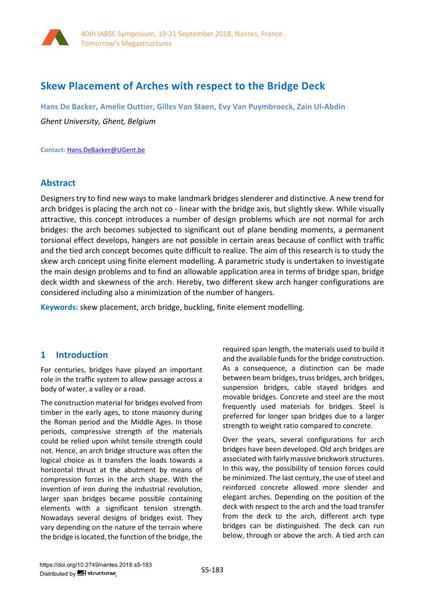Skew Placement of Arches with respect to the Bridge Deck

|
|
|||||||||||
Bibliographic Details
| Author(s): |
Hans De Backer
(Ghent University, Ghent, Belgium)
Amelie Outtier (Ghent University, Ghent, Belgium) Gilles Van Staen Evy Van Puymbroeck (Ghent University, Ghent, Belgium) Zain Ul-Abdin (Ghent University, Ghent, Belgium) |
||||
|---|---|---|---|---|---|
| Medium: | conference paper | ||||
| Language(s): | English | ||||
| Conference: | IABSE Symposium: Tomorrow’s Megastructures, Nantes, France, 19-21 September 2018 | ||||
| Published in: | IABSE Symposium Nantes 2018 | ||||
|
|||||
| Page(s): | S5-183 | ||||
| Total no. of pages: | 8 | ||||
| DOI: | 10.2749/nantes.2018.s5-183 | ||||
| Abstract: |
Designers try to find new ways to make landmark bridges slenderer and distinctive. A new trend for arch bridges is placing the arch not co - linear with the bridge axis, but slightly skew. While visually attractive, this concept introduces a number of design problems which are not normal for arch bridges: the arch becomes subjected to significant out of plane bending moments, a permanent torsional effect develops, hangers are not possible in certain areas because of conflict with traffic and the tied arch concept becomes quite difficult to realize. The aim of this research is to study the skew arch concept using finite element modelling. A parametric study is undertaken to investigate the main design problems and to find an allowable application area in terms of bridge span, bridge deck width and skewness of the arch. Hereby, two different skew arch hanger configurations are considered including also a minimization of the number of hangers. |
||||
| Keywords: |
arch bridge finite element modeling (FEM) buckling skew placement
|
||||
